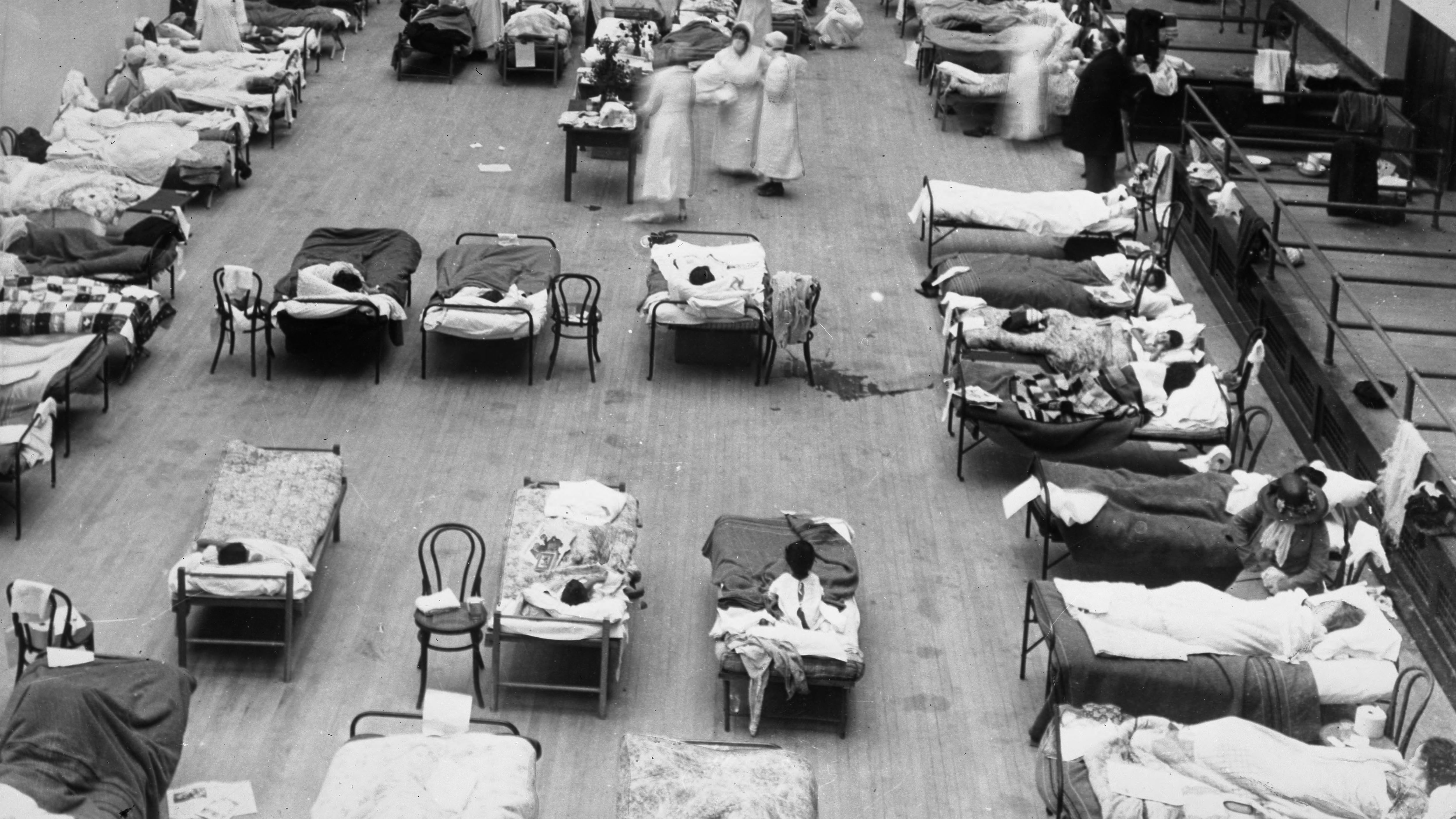A little over a century ago, 100 beds and straw-filled mattresses were hauled into what's now Keller Auditorium. It was mid-October 1918, and the planet was in the midst of one of the deadliest pandemics of modern times: the so-called Spanish influenza. The disease had arrived in Portland earlier that month, and quickly overwhelmed the health care system. The performing arts theater, then known as Portland Public Auditorium, had been commandeered as a makeshift hospital for Portlanders who had no one to care for them or no means for private care.
Within days, the beds were full. By the end of the month, the city's morgues were at capacity.
The spread of the coronavirus, and the response to it, may seem unprecedented in our civic experience. But the similarities between COVID-19 and the malady that stole into the City of Roses in the early 20th century are almost eerie, from the sloganeering to the lack of preparedness to the antecedents of the "social distancing" measures we're grappling with today. Portland spent weeks learning to live with the modifications to daily life necessitated by a pandemic. Examining how we reacted then helps place into context what's happening now—and perhaps offers a glimpse of where we're heading.
Despite its name, the Spanish flu is actually thought to have originated in Kansas—blame the moniker on the same xenophobic forces that attempted to label the current scourge "the Chinese virus." It traveled to Europe, probably via soldiers deployed "over there" for World War I, then spread across America, often following train routes. Over a quarter of the world's population fell ill, and 50 million people died. The United States suffered 675,000 deaths, including 3,688 Oregonians.
Quickly, there were 60 confirmed cases of the influenza in Portland, though the real number was more likely around several hundred. Public health officials noted that large public gatherings were assisting the spread of the disease. Three hundred slides were distributed to movie theaters across Oregon to run before features, projecting catchy suggestions such as "Smother the sneeze/To prevent disease." Additional protections ordered theater staff to ban soldiers and sailors—early vectors of the disease—and to remove patrons from their seats if they coughed or sneezed during the film. Portland's streetcar system was also identified as a conveyor, and signs cautioned commuters to curtail coughing, sneezing and spitting. Telephone mouthpieces in public places were sanitized.
As cases increased, cities across the nation, including several in the Pacific Northwest, implemented various versions of quarantines and population restrictions. But Portland's mayor, George Baker, initially opposed "closing" the city. With some reluctance, he eventually agreed to a shutdown at the insistence of the U.S. surgeon general and Oregon state health officials. All 50 of Portland's theaters were locked. The garish glow of the marquees along Broadway dimmed, and schoolchildren rejoiced at their freedom.
Baker's "closing" was different from today's "stay at home" edict, though. It was thought that spreading out rush-hour traffic could curtail the spread, so shops limited hours in an effort to "flatten the curve," so to speak. But Portlanders could still visit pool halls, card rooms and bowling alleys—they were just requested to maintain 4 feet of distance from one another.
By mid-October, hospitals quickly filled with the sick. Twenty-five patients were immediately admitted to the makeshift hospital at the Public Auditorium; the Parks Bureau provided fresh-cut flowers in an attempt to liven up the space. A day later, there were 70 patients, and staff added 200 beds. Soon, there were 779 cases of the influenza in Portland. Outside Multnomah County Hospital, two large tents were erected as temporary hospital wards.
By Oct. 22, 12 days after Mayor Baker "shut down" the city, 1,161 Portlanders were infected with the flu, and 41 had died. That number leaped to 214 deaths by the end of the month. Gravediggers were scarce, and those at work were busy.
To aid in battling the outbreak, citizens were told to keep their windows open, despite the chilly fall weather. Mass transit was ordered to follow suit. Like today, the public was bombarded with reminders to wash their hands, and the Red Cross publicized directions for how to make face masks at home out of gauze. Offices, however, did not close down.
Six weeks later, the influenza had begun to wane, and Baker lifted the closure. Just in time, too: The armistice of World War I was announced, and a festive mood struck the town. Portlanders packed reopened theaters and neighborhood churches, and parties drew thousands into the streets. The previous 4-foot personal buffers were ignored, and bodies pressed against each other as war-weary revelers laughed, hugged and danced in celebration.
Yet the disease was still present, and still deadly. But with only 10 people dying each day, it was seen as largely "contained." There were recurrent outbreaks over the next year, and Portlanders continued to die. But officials felt that they had a handle on the pandemic. Measures shifted to quarantining homes that suffered the illness for up to 10 days rather than "closing" the entire city once again.
Portland's response to the pandemic was fairly middle of the road compared to that of other American cities. Sacramento, Calif., for instance, considered a mask ordinance months before Portland's finally passed, and citizens in Spokane, Wash., faced arrest if found without the protective gear. The attitude of Portlanders in 1918 seems consistent with the images coming from the Oregon Coast today. As Dr. E. A. Sommer of the 1918 Consolidated Health Board put it, "The biggest thing we have had to fight in the influenza epidemic has been apathy, or perhaps the careless selfishness of the public."
Of course, there are few people still around who remember those six weeks of hardship, but there are several establishments that managed to weather the "shutdown" of 1918 and survive another century: Huber's, Kelly's Olympian, Jake's and the Clinton Street Theater, to name a few.

"That's really what's remarkable, and kind of a miracle, about the Clinton," says Roger Leigh, current owner of the now-dormant 105-year-old movie house. "It really only survived because of community. There's a lot of theaters that hung in there because they were bigger or fancier. But little hole-in-the-wall theaters are pretty rare these days."
One hundred and two years later, the theater again faces a pandemic and an existential crisis, and once again, it may have to rely on the community to make it through. It's something to remember—along with smothering our sneezes.
Doug Kenck-Crispin is a local historian and host of the Kick Ass Oregon History podcast.

